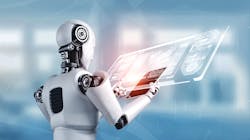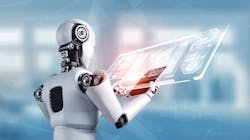AI is leveraging advanced analytics for physical security operations
The paradigm shift in physical security from a reactionary and defensive proposition to a more proactive stance has characterized the migration of advanced analytics into almost every platform. Security end-user demanding systems that are faster and more intelligent, and at the same time cost-efficient and better suited for integrated solutions, are looking for more than technology that detects and deters. They now require systems that can digest vast amounts of data, then process autonomously monitored responses at lightning speeds. Upping the preemptive ante is a crucial step in the growth of intelligent physical security systems. And it is currently moving beyond the ubiquitous use of video surveillance analytics to other sensory devices at the edge and controlling access into and across the interior of a facility.
This improvement in security operations at the enterprise level is also addressing the convergence of physical and cybersecurity threats while easing the migration into a more defined digital world. As stated in a recent Security Industry Association (SIA) report: “Security will move beyond video surveillance and access control with features such as autonomous reporting, monitoring and response. Autonomous security systems will communicate with each other and with people and will act on their own to collect more information and trigger complex safety protocols. Security technology will operate with predictive intelligence and will be deeply integrated with building systems, including HVAC, lighting, elevators and fire alarm and suppression. Remote monitoring capabilities will be the norm and this interconnectivity will bring the Internet of Things (IoT), 5G edge sensors, mobile devices, body-worn cameras, robots, drones, contextual conversational AI and augmented reality together to provide frictionless access, risk analysis, and predictive behaviors for proactive responses with real-time machine intelligence.”AI Solutions are Not Just for Video Surveillance
For example, says Sam Joseph, co-founder and chief executive officer of Hakimo, whose company develops software for the physical security industry powered by artificial intelligence (AI), “suppose you work at Google or any big enterprise and you have offices in San Francisco and in New York, and suppose you are in the San Francisco office, or somewhere on the west coast, logging into your email using single sign-on or any other standard techniques. If someone uses your badge or a cloned badge of yours in New York, these two pieces of information are stored in completely separate systems. No one will notice that there is no system connecting the two, and a security breach as obvious as this goes completely undetected today.”
Joseph, like many technologists who have made their way into the physical security industry because they see a sector that is moving forward despite itself, contends that physical security systems have lagged behind cybersecurity advancements for the previous two decades because many systems operators are overwhelmed with incoming data and constant alerts that distract more than inform and that is more than most humans can manage.
“This was a problem that cybersecurity faced in the 2000s. Fifteen, twenty years ago when cybersecurity systems started generating a lot of alerts, there was no way a human analyst or a human operator could monitor them all effectively,” Joseph continues, pointing out that the cybersecurity industry quickly developed tools like Security Information and Event Management (SIEM) and Orchestration, Automation and Response (SOAR) software to simplify the data tsunami. “Physical security has reached that point only now. And one reason convergence is getting delayed is that cybersecurity is way ahead in terms of tools and techniques. Physical security is still lagging behind. Our vision is to elevate physical security quickly to cybersecurity levels so that cases like the previous examples can be easily resolved.”
The Hakimo software streamlines the workflow of a global security operations center (GSOC) by freeing up time for operators and by surfacing security threats that would have gone unnoticed previously. The AI algorithms in the Hakimo software initially serviced video surveillance platforms, but working closely with security end-users, the need to rectify the GSOC logjams and improve security accountability of access control systems moved the solution in another direction.
“Security is not just about video. There is access control that can track patterns that every employee exhibits and so on. There are many applications beyond video for which we could use AI to detect anomalies, detect vulnerabilities and anomalous events. Even though we started out with video, there has been a natural progression to our product today based on customer feedback and based on our expertise in other industries like cybersecurity where AI has done important things,” says Joseph.
Access Control Systems Expand Capabilities with AI
His team’s software application with its data analytics algorithms can also analyze alarms across time and diagnose faulty hardware, such as door sensors and sensors. Pointing out anomalies in cardholder behavior is a crucial tool for access control accountability. The software can point out impossible travel (the same card being used at multiple locations within a short duration which is physically impossible), unusual time or location of usage.
“The real world is complicated when working with physical security. Of course, somebody from the cybersecurity world can argue that cybersecurity is also complicated, but one of the big challenges that we face with physical security are the disparate systems. Just take cameras, for example. Every time there's an access control event, we look at the corresponding video and analyze what's happening. We still run into customers that have 10% analog cameras in their fleet. Then there are other customers that might have advanced five-megapixel or even better cameras. Some might have standard VGA cameras from five years ago or ten years ago,” admits Joseph. “So, one challenge that we constantly run into is how can we build algorithms that can handle high-resolution footage from a five-megapixel camera, as well as a 320p or 480p or a small resolution camera.
“That's just resolution. That's just one dimension. You have solutions like this across other dimensions,” he continues. “It could be the kind of door. You might have a glass door, a wooden door. In different lighting conditions, the camera might be outside facing the door or inside facing outside. And if there is sun outside with a lot of glare coming in. So, just with cameras, there are plenty of challenges. Now you add one more dimension, where you have different access control systems. C-CURE does things in one way, Lenel does things in another way. Pro-Watch just has a slightly different look and S2 has a completely different architecture. Building something that works with different kinds of systems and different kinds of real-world environments is also the biggest challenge, but it has also become our biggest strength.”
COVID Has Increased the AI Urgency Factor
Those strengths have been more than tested over the last 24 months with the lingering COVID crisis that has staggered office time for workers and challenged employers to provide an extra measure when it comes to duty of care. The mindset of what an access control system is and what it should do has been turned on its head. For Joseph, the present environment has been a motivating element for a changing technology segment.“COVID was a significant change for the physical security departments within enterprises because everyone started turning to physical security and asking, ‘How many people are there in the building today? What's our occupancy right now?’ That data was always there in your Lenel database or in your C-CURE systems, but nobody cared to leverage it. This crisis has shown, in some sense, the value that the data sitting in these systems have in general for security, health and safety. It also showed how difficult it is to do something extremely basic,” Joseph says. “We literally have talked to customers who were running reports daily in Lenel, exporting into a spreadsheet, and then copy-pasting the data into a different spreadsheet and before finally building graphs on their own tools to show how building utilization is changing across time.”
Joseph continues that it is all about the software now. And when he and his company talk about software, it is an AI-driven solution.
“We put zero hardware in the field. We just take in the existing cameras, existing access control systems and use our algorithms. It shows how software has become much more powerful and important than hardware when integrating a system. Even if you have a suboptimal camera or suboptimal hardware in the field, superior software can make up for that. And when I say software, I'm using software as a general term that includes AI,” he adds.
Future Trends
Given the steady migration of AI into the physical security space, where does Joseph see the evolution of AI-based access control solutions going five or ten years down the road?
“It's a very general point, but one clear trend is the declining number of security guards; there's a huge labor shortage. While the number of guards is going down, the number of sensors in the industry is growing exponentially. So, there's a real need in the industry to monitor all these sensors and monitor all these cameras. We see monitoring emerging as the largest sector within the physical security industry. AI is desperately needed because we literally don't have enough humans to look at all these cameras,” concludes Joseph. “If you don't have anyone looking at it, it just becomes a forensic tool, which it has historically been in most cases. Analyzing video at scale, analyzing events at scale will be the primary use case for AI.”
About the Author: Steve Lasky is a 34-year veteran of the security industry and an award-winning journalist. He is the editorial director of the Endeavor Business Media Security Group, which includes magazines Security Technology Executive, Security Business and Locksmith Ledger International and top-rated webportal SecurityInfoWatch.com. Steve can be reached at [email protected].
About the Author
Steve Lasky
Editorial Director, Editor-in-Chief/Security Technology Executive
Steve Lasky is Editorial Director of the Endeavor Business Media Security Group, which includes SecurityInfoWatch.com, as well as Security Business, Security Technology Executive, and Locksmith Ledger magazines. He is also the host of the SecurityDNA podcast series. Reach him at [email protected].



